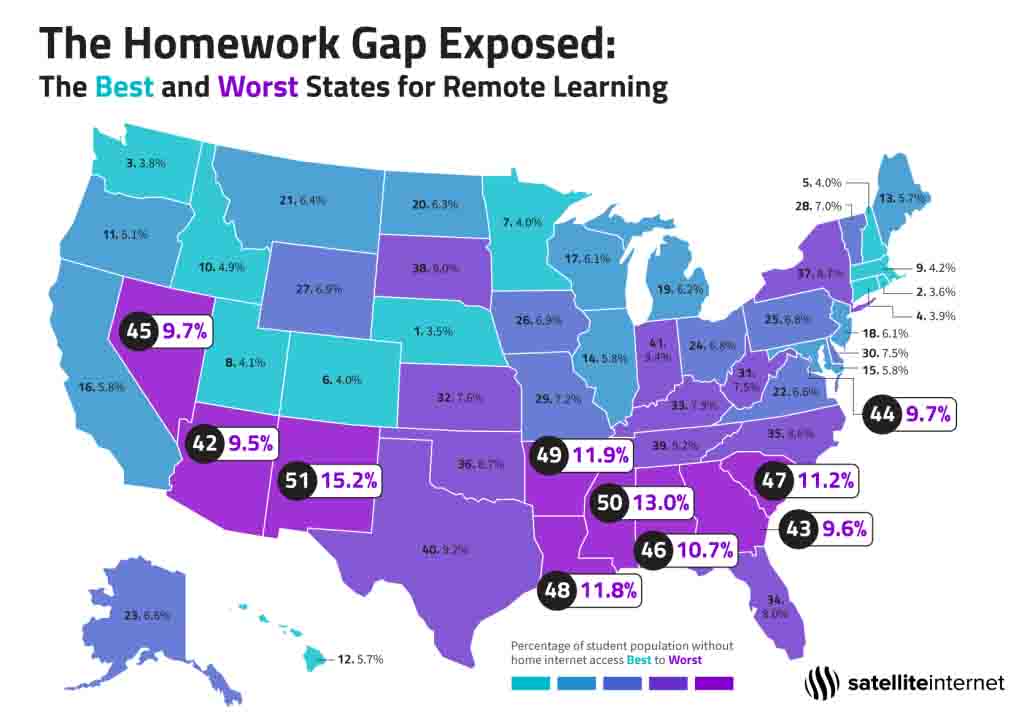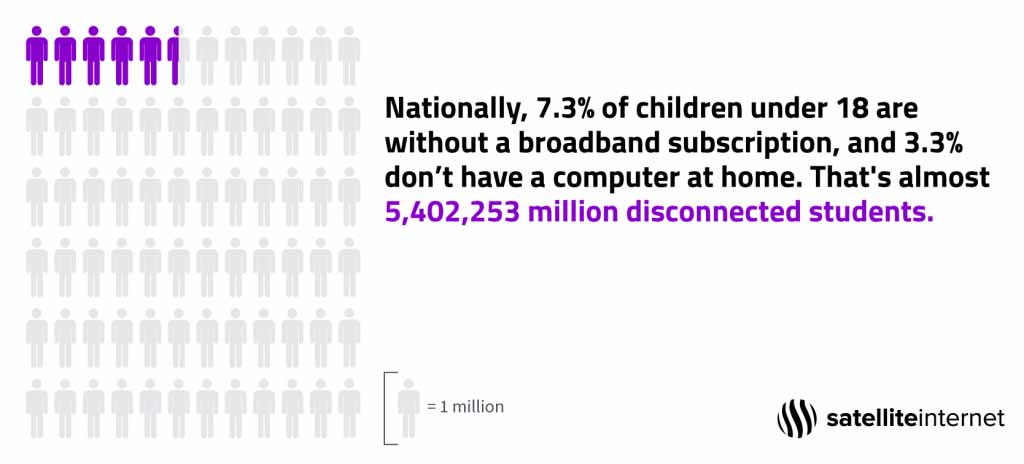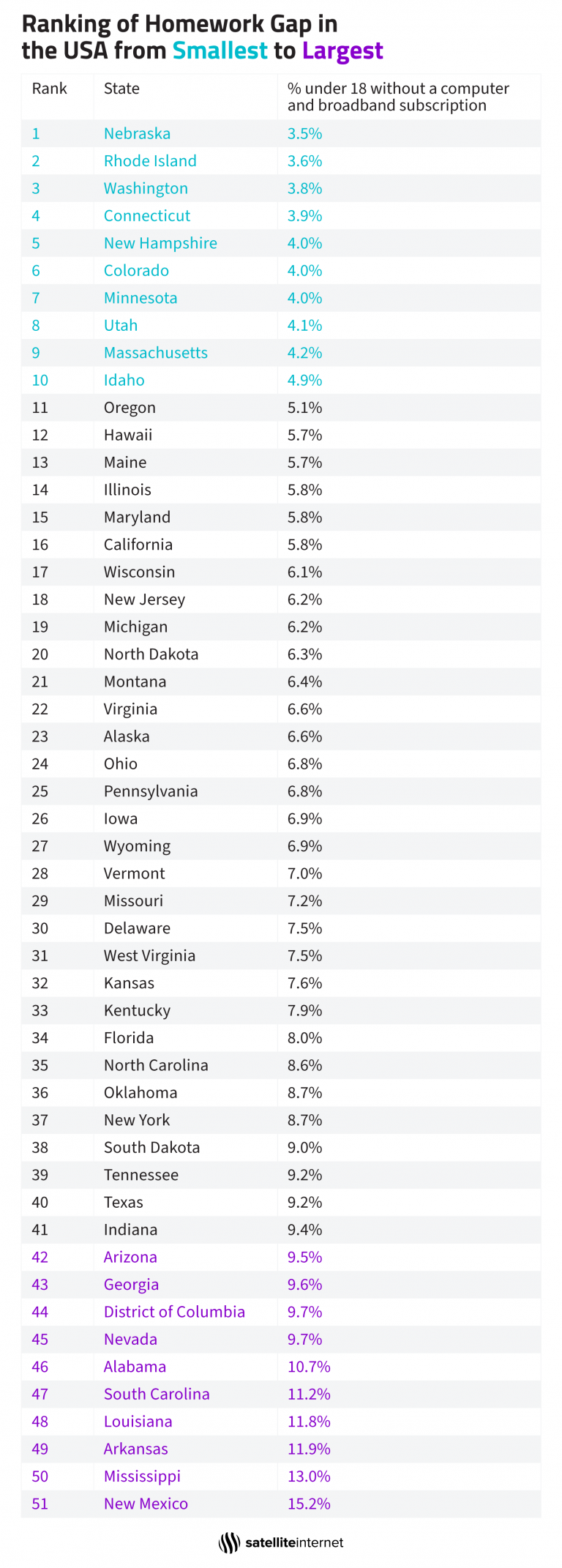The Homework Gap Exposed: The 10 Worst and Best States for Remote Learning
During the pandemic, nearly 93% of school-age children did some form of remote learning.1 Even when they have the equipment and internet resources they need, the switch to distance education has been difficult for students, teachers, and parents alike.
But what about those households that fall into the “homework gap”?
Coined by FCC Commissioner Jessica Rosenworcel, the term “homework gap” describes the divide between students with broadband access at home and without. It’s an indicator of whether or not a student will complete their homework and succeed at the same rate as their internet-connected peers.
But it’s more than getting homework done online. Missing out on connectivity has lifelong consequences:
- 47% of students who have no home internet access (or have internet access only through a cell phone) complete a post-secondary program, compared to 65% of those with fast home internet.2
- Students with lower-than-average digital skills are 29% less likely to plan to complete a college or university program.
- Kids without home internet access also generally have lower grades and test scores, demonstrate less competency in digital skills, and are less likely to plan to attend post-secondary schooling, even after accounting for socioeconomic differences.3
Nationally, 7.3% of children under 18 are without a broadband subscription, and 3.3% don’t have a computer at home—that’s over 5.4 million students.4 But some states experience a far greater digital divide than others.
We compared the standard classroom size of each state (sourced from Public School Review) with the percentage of students without at-home computer access or broadband subscriptions (sourced from the US Census Bureau) to determine the states with the most and fewest internet resources for students.
So, which states are the worst places for school-aged children to participate in remote learning? To see where your state lands, read on or jump to the full data set below.

Top 10 states with the biggest homework gap
When broken down by state, the largest homework gaps in America range from 10% to 15% of students without connectivity. Compared to some of the most well-connected states, the digital divide in these states is about two to five times larger.
The digital divide is made more visible along state lines
- The digital divide is the worst for students in New Mexico, where 15.2% of those under 18 don’t have a computer and broadband subscription.
- Arizona and Nevada also have high populations of students experiencing the homework gap, leaving many in the Southwest without the ability to connect—especially during COVID-19 shutdowns.
- In southern states such as Mississippi, Arkansas, Louisiana, South Carolina, Alabama, and Georgia, anywhere from 9.6% to 13% of kids under 18 can’t connect.
- Even in our nation's capital, nearly 10% of students are without access to online learning.
- The states with the biggest homework gap all have poverty rates of 13% or higher.5
- The 10 states with the least connected students have a homework gap average of 11.2%
According to the Pew Research Center, 59% of parents classified as low-income said their child either had to do schoolwork on their phone, use public Wi-Fi due to slow home internet, or didn’t have access to a home computer.
Furthermore, the homework gap is not only about affordability but also about availability and access, which means it can hit rural communities even harder.
Top 10 states with the most connected students
Fortunately, the vast majority of the student population in most states has internet access. However, the digital divide is still real for these states, along with other pandemic-related struggles.
Key Findings:
- Nebraska has the best connectivity for students in the nation. In The Cornhusker State, 96.5% of students are connected.
- In the northeastern part of the United States, Rhode Island, Connecticut, New Hampshire, and Massachusetts have about 95.8% or more students with home internet access.
- Some states in the West are at the top of the list, with at least 95% of the student population connected at home in Colorado, Utah, and Idaho.
- The 10 states with the most connected students have a homework gap average of 4%.
According to the Pew Research Center, 59% of parents classified as low-income said their child either had to do schoolwork on their phone, use public Wi-Fi due to slow home internet, or didn’t have access to a home computer.
Furthermore, the homework gap is not only about affordability but also about availability and access, which means it can hit rural communities even harder.
“Our county issued every student a Chromebook if they didn't have access to a reliable computer or laptop at home. We even provided a MiFi hotspot for students without internet access,” says Ginean Royal, a high school math teacher in North Carolina. While the national homework gap remains a problem for millions of students, “The desire to sit at a computer daily and get the classwork done is another issue,” she said.

How can we reduce the homework gap in the US?
Although remote learning presents a variety of challenges, the homework gap is ultimately about funding and access to internet, including in rural areas.
Currently, we can see efforts from federal, state, and community-level programs to distribute more funds to schools and households. And telecommunications corporations are also stepping in to assist students—so how will the homework gap look next year?
As the pandemic continues to increase awareness of the digital divide in the US, we can work toward minimizing the homework gap in America. By making sure every student has the tools, resources, and access they need, we hope to see more students succeed and stay engaged in learning

Methodology
We compared the standard classroom size of each state (sourced from Public School Review) with the percentage of students without at-home computer access or broadband subscriptions (sourced from the US Census Bureau) to determine the states with the most and fewest internet resources for students.
In order to measure each state’s “homework gap,” we ranked states based on the percentage of the population 18 years old and under with home access to a computer and a broadband internet subscription.
Sources
- Kevin McElrath, Census.gov, “Nearly 93% of Households With School-Age Children Report Some Form of Distance Learning During COVID-19,” August 26, 2020.
- Benton.org, “Schooling During the COVID-19 Pandemic,” March 6, 2020.
- Hampton, K. N., Fernandez, L., Robertson, C. T., & Bauer, J. M., Michigan State University, “Broadband and Student Performance Gaps – Quello Center,” December 2018.
- US Census Bureau, “Age by Presence of a Computer and Types of Internet Subscription in Household,” Accessed April 8, 2021.
- US Census Bureau, “2019 Poverty Rate in the United States,” Accessed April 8, 2021.